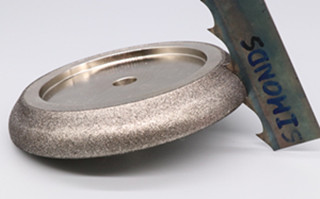Analysis and solutions of the coating falling off of electroplated diamond tools
With the development of economy and the progress of science and technology, different industries have basically the same requirements for electroplated diamond tools, that is, high efficiency, long life, and high grinding precision. To ensure these characteristics, the coated metal must not only have higher hardness and wear resistance, but also must be evenly distributed in all parts of the substrate to prevent the coating from falling off and shorten the tool life. In some special industries, such as powerful grinding in the magnetic material industry, the feed rate is controlled at about 0.3mm.
In the ceramic industry, such as dry grinding with a large feed rate, the bonding force between the coated metal and the steel substrate is particularly demanding. In the production process of electroplated diamond tools, most manufacturers only pay attention to the type, hardness, and wear resistance of the coating metal, but often ignore the problem of the adhesion of the coating metal to the substrate. In actual use, it is not uncommon for the coating to fall off. This article analyzes the causes of this problem and discusses the solutions.
Types of coating peeling
During the use of electroplated diamond tools, due to the use conditions such as grinding force, temperature rise, workpiece impact, etc., the metal coating containing diamond will separate from the steel substrate, which is the peeling of the coating. The peeling off of the plating layer is generally partial peeling, and it is rare that the plating layer is peeled off at one time. In actual use, there are roughly three situations in which the coating falls off:
1.The coating falls off to the surface of the substrate: that is, the diamond-containing metal coating and the diamond-free metal bottom coating are separated from the steel substrate at the same time.
2.The layer falls off to the metal bottom coating: that is, the metal bottom coating without diamond is not separated from the steel substrate, but the diamond-containing metal coating and the metal bottom coating are peeled off.
3.The layered separation of the coating metal in the diamond-containing metal coating: During the use of the diamond-containing metal coating, the coating metal in the contact part of the workpiece is not normally abraded, but falls off abnormally in flakes or powder, and the diamonds are not completely peeled off. Instead, it falls off locally and granularly. This phenomenon is not easy to attract attention, and the consequence is that the product life is short, and it often gives the illusion of poor holding power or wear resistance of the coated metal. Excluding factors such as scorching of the coating during thickening and poor wear resistance of the coating metal, the drop of diamond particles during normal use of the tool is intuitively manifested as the surface of the tool has continuous large holes, which should be the drop of this type of coating.
Causes of coating peeling
Electroplated diamond tools involve multiple processes in the manufacturing process, and if any process is not fully performed, the plating layer will fall off.
Measures to solve the coating peeling off
In view of the reasons for the peeling of the coating, the following measures can be taken to solve the problem of the coating:
1.Strengthen the pre-plating treatment to completely remove the burrs, oil stains, oxide film, rust and oxide scale on the surface of the substrate as much as possible, promote the normal growth of the plated metal lattice, and improve the
bonding force between the plated metal and the base metal.
2.Optimize the plating solution formula and plating process, adopt charged into the tank to prevent bipolar phenomenon, and adopt short-time high-current impulse empty plating for workpieces with complex shapes to reduce the influence of coating internal stress and hydrogen evolution, and improve coating quality.
3.Optimize the process and procedures to reduce the power-off time during sand unloading, and even unload the sand in the original sanding tank, thicken it or unload the sand in a spare tank with electricity to improve the bonding force between the diamond particles and the coating. If there is a power outage during the thickening process, the workpiece should be put into the electrolyte for cathodic reduction during the thickening process, and then charged into the tank for electroplating to ensure the adhesion of the coating.

